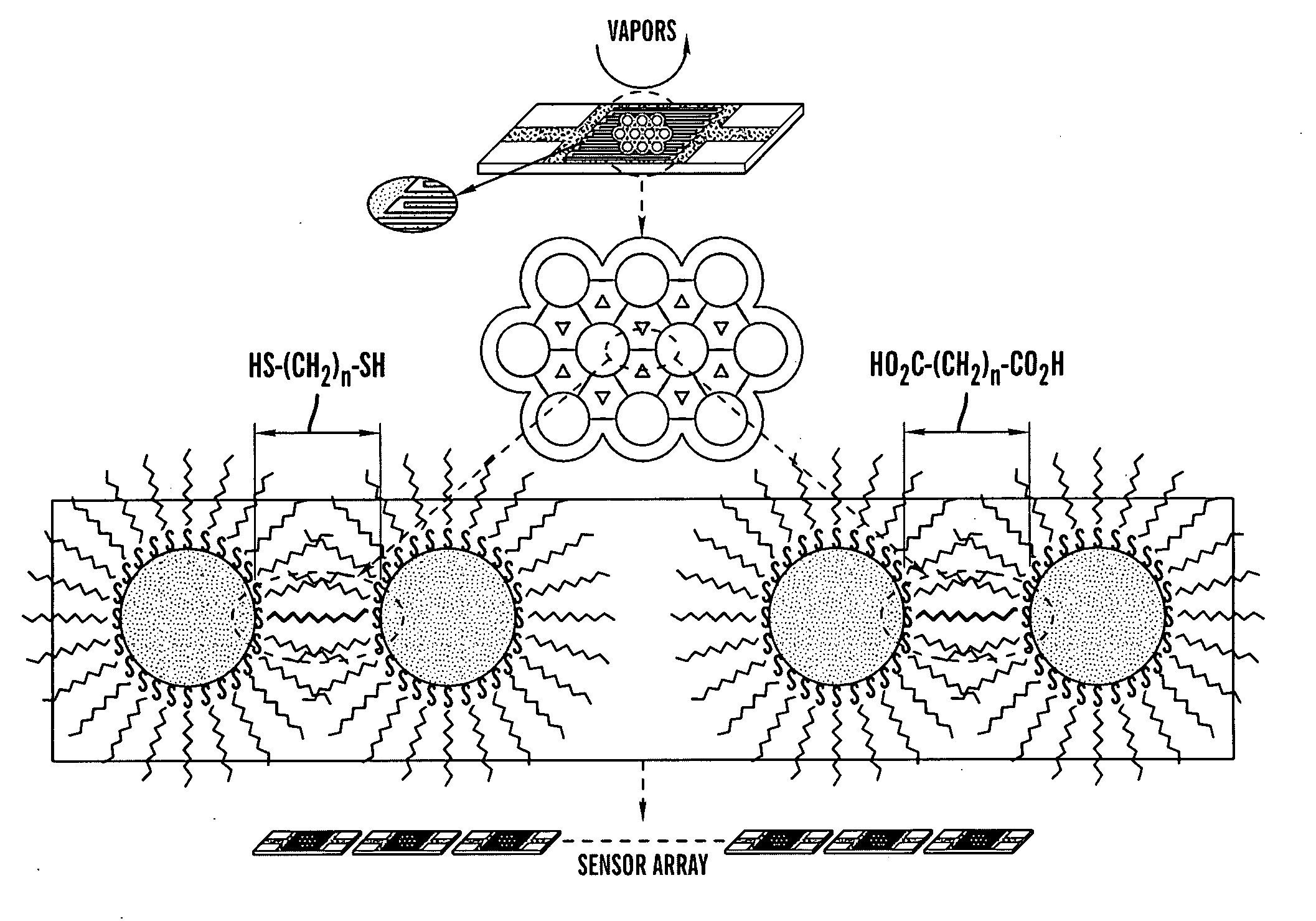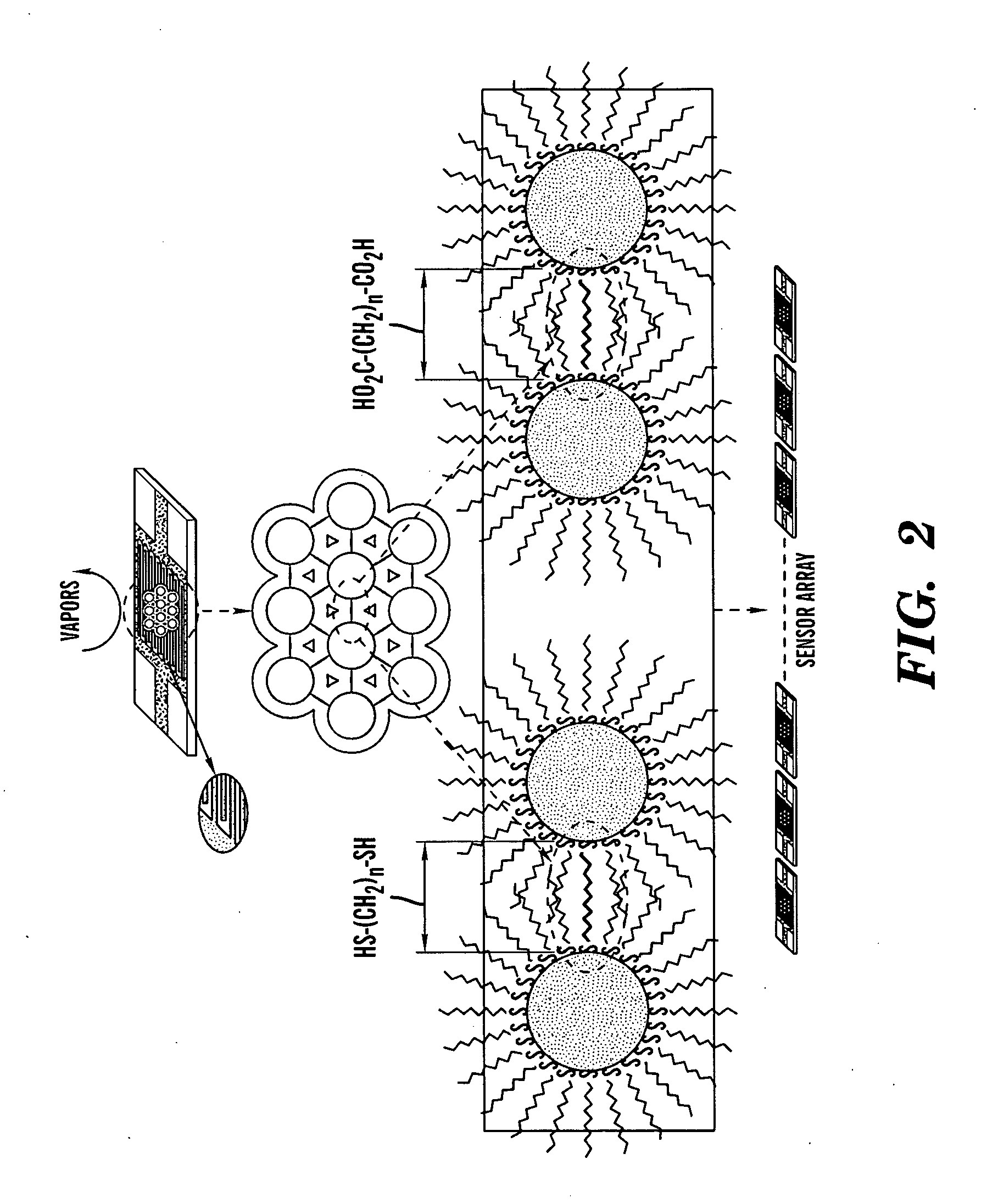Multi-moduled nanoparticle-structured sensing array and pattern recognition device for detection of acetone in breath
a nanoparticle structure and sensor array technology, applied in the field of multi-moduled nanoparticle structure sensing array and pattern recognition device for detection of acetone in breath, can solve the problems of lack of selectivity, limited sensitivity, selectivity, and response speed of some systems, especially in monitoring applications, to achieve the effect of improving detection accuracy, reducing detection cost, and improving detection accuracy
- Summary
- Abstract
- Description
- Claims
- Application Information
AI Technical Summary
Benefits of technology
Problems solved by technology
Method used
Image
Examples
example 1
Chemicals
[0061]Hydrogen tetrachloroaurate trihydrate (HAuCl4.3H2O, 99%), silver nitrate (AgNO3, 99+%), potassium bromide (KBr, 99+%), tetraoctylammonium bromide (TOA+Br−, 99%), decanethiol (DT, 96%), sodium borohydride (NaBH4, 99%) were purchased from Aldrich. Alkyl dithiols (ADT, HS—(CH2)n—SH) included 1,3-propanedithiol (n=3, 99%), 1,5-pentanedithiol (n=5, 96%), 1,8-Octanedithiol (n=8, 97%), 1,9-nonadithiol (n=9, 95%), which were purchased from Aldrich and used as received. 1,10-decanedithiol (n=10, 90%) was purchased from TCI and used as received. Dicarboxylic acids (DCA, HO2C—(CH2)n—CO2H) included dodecanedioic acid (n=10, 99%) and 1,14-tetradecanedicarboxylic acid (n=14, 96%), which were purchased from Aldrich, and 1,12-dodecanedicarboxylic acid (n=12, 98%), 1,13-tridecanedicarboxylic acid (n=13, 97%), 1,16-hexadecanedicarboxylic acid (n=16, 97%), and 1,18-octadecanedicarboxylic acid (n=18, 99%), which were purchased from TCI and used as received. Solvents included hexane (99.9...
example 2
Synthesis of Nanoparticles
[0062]Au nanoparticles of 2 nm core size encapsulated with decanethiolate (DT) monolayer shells were synthesized by two-phase reduction of AuCl4− according to Brust's method and a synthetic modification. See Brust, M., et al., J. Chem. Soc., Chem. Commun., 7: 801 (1994) and Hostetler, M., et al., Langmuir, 14: 17 (1998), which are hereby incorporated by reference in their entirety. Details for the synthesis of gold nanoparticles (2.0±0.7 nm core size) were also previously described. See Maye, M., et al., Langmuir, 16: 490-497 (2000), which is hereby incorporated by reference in its entirety. AuAg alloy nanoparticles (3.0±0.5 nm core size) capped with DT monolayer shells were synthesized by a two-phase reduction of AuCl4− and AgBr2−, details of which were recently reported. See Kariuki, N. N., et al., Langmuir. 20: 11240 (2004), which is hereby incorporated by reference in its entirety. AuAg nanoparticles with a Au:Ag ratio of 1:3 in the nanoparticle were sy...
example 3
Preparation of Thin Film Assembly
[0063]The general preparation of the thin films followed the one-step exchange-crosslinking-precipitation method reported for gold and AuAg nanoparticles. See Han, L., et al., Anal Chem., 73: 4441 (2001); Han, L., et al., J. Mater. Chem., 11: 1258 (2001); and Kariuki, N., et al., Chem. Mater., 18: 123 (2006), which are hereby incorporated by reference in their entirety. Briefly, the procedure involves immersion of substrates (e.g., glass, electrodes etc.) into a hexane solution of DT-capped Au (30 μM) and ADT (50 mM) for the ADT-Au assembly, or a mixture of hexane solution of DT-capped AuAg nanoparticles (1.0 μM) and ethanol or tetrahydrofuran solution of DCA (20 mM) for the DCA-AuAg assembly. The reaction was carried out at room temperature. ADT or DCA function as a mediator or cross-linking agent. The mediator to nanoparticle ratio was controlled, typically about 100:1. The pre-cleaned substrates or devices were immersed vertically into the assembl...
PUM
| Property | Measurement | Unit |
|---|---|---|
| temperature | aaaaa | aaaaa |
| core size | aaaaa | aaaaa |
| thickness | aaaaa | aaaaa |
Abstract
Description
Claims
Application Information
 Login to View More
Login to View More - R&D
- Intellectual Property
- Life Sciences
- Materials
- Tech Scout
- Unparalleled Data Quality
- Higher Quality Content
- 60% Fewer Hallucinations
Browse by: Latest US Patents, China's latest patents, Technical Efficacy Thesaurus, Application Domain, Technology Topic, Popular Technical Reports.
© 2025 PatSnap. All rights reserved.Legal|Privacy policy|Modern Slavery Act Transparency Statement|Sitemap|About US| Contact US: help@patsnap.com



